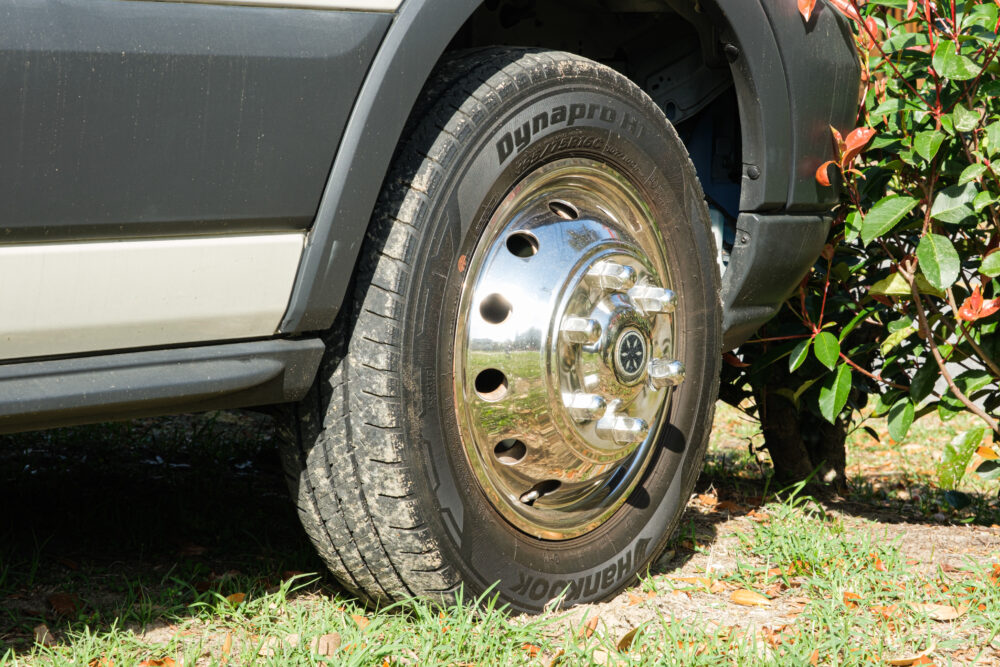
What You Need To Know About RV Wheel Maintenance
Most towable RV owners already know that there is a lot riding on their RV wheels. The good news is that if you take care of your RV trailer wheels, they’ll take care of your RV while you are traveling.
Taking care of your RV trailer wheels includes doing regular inspections and maintenance before, during, and after your camping trips. In this article, I’ll discuss what you need to do to help make sure your wheels can get you where you’re going safely.
When to inspect RV wheel bearings
There are two things you need to do to your RV before you go anywhere with your travel trailer or fifth wheel. If you aren’t comfortable doing this work yourself (or don’t have tools), you can get a certified RV technician to do it. Don’t skip these simple RV wheel maintenance jobs.
RV wheel bearings are designed to keep your RV wheels going around. If they aren’t kept clean and swimming in unadulterated wheel bearing grease, your RV wheels will seize, potentially causing an accident and/or massive damage to your RV. Wheel bearings need to be inspected and maintained on an annual basis, no matter how many miles you travel with your RV.
How to repack RV wheel bearings
Inspecting and repacking your wheel bearings is an easy job, but you may wish to hire a professional to do it, especially if you haven’t been keeping up with annual maintenance. A certified RV technician will be able to use his or her trained eyes to find things that are wearing out in your RV wheels.
Even if you’ve been keeping up with annual wheel maintenance, listen for unusual noises coming from your RV trailer wheels while you’re driving. Check your wheels for play by holding each wheel at 10 o’clock and 2 o’clock and pulling it towards you and then pushing it away from you. If the wheel rocks back and forth at all, it means there is something up with your wheel bearings.
Here are some other tips to consider:
- It is recommended to have a professional inspect your wheel bearings every year or every 12,000 miles, whichever comes first.
- When checking your wheels for play, you should also check for any unusual heat coming from the wheel hub, as this can be a sign of a bad wheel bearing or other issue.
- In addition to uneven tire wear, other signs of worn wheel bearings include unusual noises (such as humming or grinding sounds) coming from the wheels, wheel vibration, and poor handling or steering.
If you see any sign of worn wheel bearings, you should get your RV wheels checked out by an RV technician before you take it anywhere else.
When to torque your RV wheel lug nuts
One of the essential tools you should always have in your RV toolkit is a torque wrench with a socket that fits your RV trailer wheel lug nuts. If your RV lug nuts loosen or fall off, the wheel lugs can break off or damage your RV wheels. You could even lose a wheel. The manual for your RV will tell you exactly how many foot pounds to torque your wheels to. This is not a suggestion. RV manufacturers know what they are doing and you should stick with what they tell you.
After any wheel work has been done on your RV wheels, they should be torqued to the correct amount after 60 miles (100 km), 300 miles (500 km), and 600 miles (1000 km). You should also retorque trailer wheels after driving on steep terrain that requires a lot of braking. Always torque your wheels in a star pattern.
How to use A torque wrench:
- Loosen the tightener at the end of the handle, just until you don’t feel much resistance.
- Set the foot pounds to the recommended level. To do this, twist the handle until it is level with the bottom of the line on the torque setting you want.
- Find the correct socket size for your wheel lug nuts. Slide this onto the square socket holder on the head of the wrench.
- Seat the socket over the top lug nut.
- Apply pressure to the left side of the handle of the torque wrench. This will turn the lug nut to the right until you hear a click. The click tells you the lug nut is now at the correct torque.
- Now move the torque wrench to the bottom left lug nut. Repeat as in Step 5 to torque the second lug nut.
- Next torque the top right lug nut.
- Now torque the top left lug nut.
- The last lug nut will be on the bottom right.
When to check your RV trailer brakes
Faulty RV wheel trailer brakes can cause deadly accidents. RV wheel trailer brake components should be checked for wear and functionality at least once a year. RV brake pads should be inspected, and mechanical components need to be cleaned and lubricated to prevent premature failure.
Track your RV maintenance
Make sure you keep track of all your RV maintenance and repairs with an online tool such as RV LIFE Maintenance. Not only can you keep all of your documents in one place, but you’ll also receive timely reminders when maintenance is due to help you avoid costly repairs and potentially serious accidents.
Related articles:



